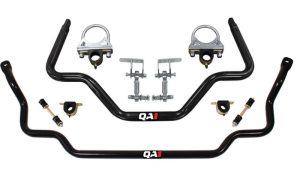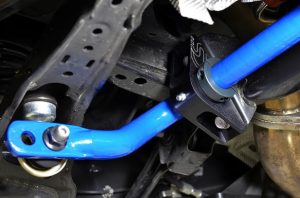In the world of performance tuning, achieving the perfect balance between handling precision and ride comfort is an ongoing pursuit. One of the most effective suspension upgrades for improving cornering stability without drastically altering ride quality is the adjustable sway bar (also known as an adjustable anti-roll bar or stabilizer bar).
These upgraded components are found in many sports cars and track-prepped vehicles, and they have become increasingly popular among enthusiasts who want more control over how their car behaves in corners. In this article, we’ll explore how adjustable sway bars work, the science behind their adjustability, their benefits and drawbacks, and how to set them up properly for your driving style.
What Is a Sway Bar and What Does It Do?

A sway bar is a torsion spring that connects the left and right wheels through short links, helping control body roll when the car corners. During turns, the suspension on the outside wheel compresses, while the inside wheel extends — creating a rolling motion that shifts the car’s weight. The sway bar resists this motion by twisting, keeping the chassis more level and improving traction balance.
Without a stabilizer bar, vehicles would feel loose and unpredictable in sharp turns. Too stiff a bar, however, can reduce grip on uneven surfaces. Adjustable sway bars give you the flexibility to fine-tune this balance.
How Adjustable Sway Bars Work
Adjustable sway bars work on a simple mechanical principle: by changing the effective length of the lever arms, you modify the bar’s stiffness. Most adjustable designs feature multiple mounting holes on the sway bar ends or adjustable linkages.
Here’s how it works:
-
Inner hole (shorter arm): Increases stiffness. Less body roll, but more understeer or oversteer potential.
-
Outer hole (longer arm): Decreases stiffness. More body roll, but smoother ride and better grip balance.
By selecting different holes or adjusting end link lengths, you can fine-tune the vehicle’s handling characteristics for road or track conditions.
Table: Comparison of Standard vs. Adjustable Sway Bars
| Feature | Standard Sway Bar | Adjustable Sway Bar |
|---|---|---|
| Tuning Flexibility | Fixed stiffness | Adjustable stiffness via multiple holes or links |
| Handling Balance | Factory preset | Tunable for understeer or oversteer |
| Ideal For | Daily driving | Performance and motorsport setups |
| Cost | Lower | Higher, due to precision design |
| Maintenance | Minimal | Requires occasional adjustment checks |
Benefits of Adjustable Sway Bars
Adjustable sway bars are not just for racers — they’re ideal for enthusiasts seeking sharper, more responsive handling. Here are the key advantages:
-
Customizable Handling Balance
-
You can dial in understeer (front bar stiffer) or oversteer (rear bar stiffer) depending on your driving style or track layout.
-
Ideal for fine-tuning suspension setups alongside coilovers or performance shocks.
-
-
Reduced Body Roll
-
Increases chassis rigidity during turns for flatter cornering and improved tire contact patch utilization.
-
-
Improved Weight Distribution
-
Keeps the car more balanced between front and rear axles, enhancing overall traction.
-
-
Enhanced Steering Response
-
Reduces delay in directional changes, giving a tighter, more predictable feel through the steering wheel.
-
-
Adaptability to Different Conditions
-
You can soften the setup for daily driving or stiffen it for track days without swapping parts.
-
Understanding Understeer and Oversteer Adjustments
Proper sway bar tuning requires understanding the handling effects of stiffness changes:
| Adjustment | Result | Driving Effect |
|---|---|---|
| Stiffer Front Bar | More understeer | Car pushes wide in corners, stable but less agile |
| Softer Front Bar | Less understeer | Improves turn-in, may cause instability if too soft |
| Stiffer Rear Bar | More oversteer | Rear steps out faster, ideal for track agility |
| Softer Rear Bar | Less oversteer | Improves grip at rear, good for wet or uneven roads |
Tip: Always adjust one bar at a time and test the car’s balance on a safe, open area before pushing limits.
Setting Up Adjustable Sway Bars: Step-by-Step
To ensure your sway bar performs optimally, follow this simple tuning process:
-
Inspect Existing Components
-
Check bushings, end links, and mounting brackets for wear or rust.
-
Replace damaged components to ensure proper alignment and function.
-
-
Start with the Middle Setting
-
Most adjustable bars have 2–3 holes per side. Begin at the middle position for baseline stiffness.
-
-
Adjust Incrementally
-
Change one level at a time and test drive.
-
Record observations — e.g., reduced roll, improved response, or new balance tendencies.
-
-
Test Both Road and Track Conditions
-
Street settings favor comfort and stability.
-
Track settings prioritize precision and cornering flatness.
-
-
Re-Torque After Driving
-
After 100–200 km, recheck all bolts and linkages to prevent loosening under load.
-
Maintenance and Care Tips
Even the best sway bars can deteriorate if not maintained properly. Follow these maintenance habits to keep performance consistent:
-
Clean the bar and bushings regularly to remove dirt and salt.
-
Lubricate polyurethane bushings with non-petroleum grease to prevent squeaks.
-
Inspect end links for play or torn boots every 10,000–15,000 km.
-
Check torque after heavy use or off-road trips.
-
Replace corroded brackets immediately to prevent alignment issues.
| Maintenance Task | Purpose | Interval |
|---|---|---|
| Clean and lubricate bushings | Prevent squeaks, reduce wear | Every 6 months |
| Inspect end links and bolts | Ensure tightness and stability | Every 10,000 km |
| Check for corrosion | Maintain structural integrity | Annually |
| Adjust stiffness settings | Optimize handling | As needed |
Are Adjustable Sway Bars Right for You?

If you value handling precision, own a performance car, or participate in track events, adjustable sway bars are one of the most rewarding upgrades you can make. They offer a noticeable improvement in cornering behavior and allow personalized tuning — something stock suspension rarely provides.
However, if you drive mostly on rough or unpaved roads, overly stiff settings can compromise comfort and traction. Proper setup and testing are key to finding the ideal balance.
Where to Buy Quality Components
When upgrading your suspension, investing in high-quality hardware ensures both performance and durability. You can Buy Stabilizer & Components online to find adjustable sway bars, end links, and bushings designed for precision fitment and long-term reliability.
Whether you’re preparing your vehicle for a spirited mountain drive or track competition, quality components and proper tuning make all the difference.
Conclusion
Adjustable sway bars combine engineering flexibility with driving finesse. They let you control how your car behaves in corners — balancing stability, grip, and comfort in ways fixed suspension components can’t match.
With regular inspection, correct setup, and the right supporting components, you can unleash your car’s full potential while maintaining reliability and control.
For optimal performance and trusted quality, always choose premium parts and Buy Stabilizer & Components online — your foundation for precise handling and confident driving on any road or track.